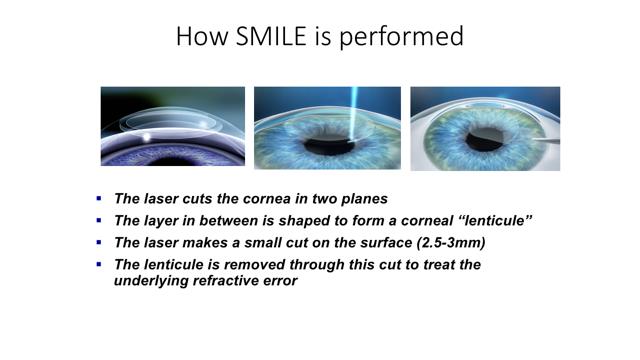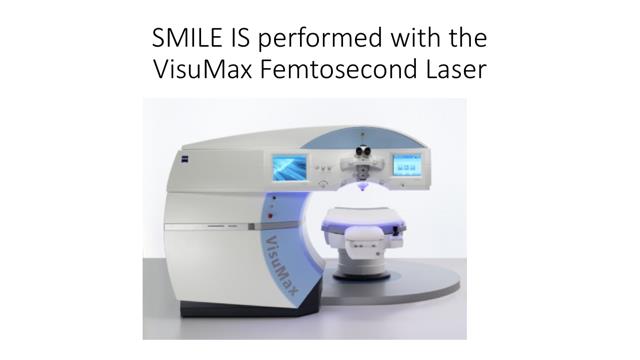ReLEx SMILE in Singapore
What is ReLEx SMILE?
ReLEx SMILE (more commonly known as just SMILE) is a fairly recently developed outpatient laser surgical procedure used to treat the following:
- Short-sightedness (myopia)
- Astigmatism
In SMILE, a small piece of tissue from within the cornea is removed to alter the shape of the cornea to improve the way light rays are focused on the retina.

SMILE is performed to decrease your reliance on glasses and contact lenses. In most cases, spectacle and contact lens independence is achieved. If you are beyond 45 years of age and require glasses for reading (a condition called presbyopia), you will probably still need your reading glasses after SMILE.

How is ReLEx SMILE performed?
Here is what to expect:
You will be awake during the surgery and no sedation is necessary.
- The procedure is generally a comfortable experience with minimal pain.
- The eye is first numbed with anaesthetic eye drops.
- The procedure involves the use of a single laser platform i.e the femtosecond laser.
- A small piece of tissue created by the laser called the cornea lenticule is removed through a small incision (wound) on the cornea. The result of removing this lenticule is to flatten the cornea in the case of short-sightedness or make it more rounded in the case of astigmatism. This changes the focusing power of the cornea and improves your vision.
- There is no cornea “flap” unlike in LASIK
- The cornea wound will self-seal without the need for stitches
- It takes generally 15-20 minutes to perform SMILE in both eyes
A video showing how SMILE eye surgery is performed. A femtosecond laser is used to create precise surgical planes within the cornea. The surgeon then removes a small piece of tissue called the “lenticule” from within the cornea, and this corrects the short-sightedness and / or astigmatism.
Am I a Good candidate for ReLEx SMILE?
Generally, in order to undergo SMILE, you should:
- Be at least 21 years of age
- Not be pregnant
- Be free of other eye diseases
- Have a stable refraction i.e the prescription for your glasses should not have changed much in the last one year
- Fulfill certain criteria with regards to cornea thickness, cornea shape and refractive error (degree). Patients with thin or irregular corneas, severe dry eye, cataract, glaucoma, uncontrolled diabetes, rheumatoid arthritis and other collagen vascular diseases are unsuitable for SMILE.
Most importantly, you must have realistic expectations about the outcome of the procedure, and be willing to accept the potential risks associated with it. Fortunately, SMILE is very safe, and the results excellent.
What to Expect after ReLEx SMILE
Here are important points to note:
- Visual recovery after SMILE is not instantaneous.
- You will find that your eye sight is still foggy immediately after SMILE. The vision usually improves gradually over the next few days. By the next day, you will be able to see well enough to perform most of your daily activities, but stabilization of vision may take several weeks.
- When the effect of the anaesthetic eye drops wears off, some patients may experience pain, tearing, burning sensation, scratchiness and / or difficulty opening their eyes, the severity of which varies from patient to patient. These symptoms usually disappear after 6-8 hours. Most patients find the discomfort mild and bearable.
- Healing after SMILE is usually comfortable as the laser removes tissue from the inside of the cornea rather than from the more sensitive surface of the cornea.
- You will be prescribed antibiotic and steroid eye drops as well as artificial tears to keep the eyes moist.
Overall, the surgery and post-surgery recovery, like LASIK, is a pleasant experience for most patients.
Most patients are able to return to work a day or two later.
Stabilization of vision varies. For some patients, it may take several weeks or a few months.
Side Effects, Risks, and Complications of ReLEx SMILE
Like any other surgery, SMILE has side effects that you need to know about and carefully consider before deciding on having the surgery. Fortunately, SMILE is a very safe procedure and most of the side effects are mild and temporary. These include dry eye, fluctuating vision, hazy vision, haloes and glare in a dim environment and light sensitivity. Over- and under-correction may also occur, and a “top up laser” procedure called “enhancement” may be required in some cases. Serious side effects that can result in loss of vision are extremely rare, and these include severe inflammation, infection and corneal ectasia (weakening and thinning of the cornea).
An Important Point to Note:
SMILE is technically more difficult to perform than LASIK eye surgery, and occasionally problems with the creation and removal of the cornea lenticule can occur during surgery. If this occurs, the doctor may choose not to complete the SMILE treatment. This is uncommon, but it is very important to choose an experienced SMILE surgeon to perform the procedure, as adequate handling of such problems during surgery comes with experience.
What Will My Vision be Like after ReLEx SMILE?
Imagine not having to fumble for your glasses to check the time when you open your eyes the first thing in the morning. Imagine not needing your glasses and contact lenses to read, drive, use the computer, swim or scuba dive. SMILE can give you this life-changing experience.
However, it is important for you to have realistic expectations when considering SMILE for yourself. Stabilization of vision takes a few weeks or a few months, and varies from patient to patient. SMILE allows most patients to perform most of their everyday tasks without glasses or contact lenses, but in some cases, these corrective aids may still be required.
SMILE cannot correct presbyopia, the age-related loss of near vision due to a loss of the auto focusing power of the eye. With or without SMILE, most patients will require glasses for reading after the age of 45. Some people choose a vision correction method called monovision, which leaves one eye slightly short-sighted to allow for close work, while the other eye is adjusted for distance vision. Monovison works well for many patients, and your eye doctor will help you decide if you are suitable for this.
Is LASIK or SMILE Better for Me?
Both LASIK and SMILE are safe and excellent laser vision correction procedures. Each procedure has its inherent advantages. Visual recovery and stabilization from LASIK is generally faster, but SMILE, being a “flap-free” procedure may be more suitable for patients involved in high impact sports and other vocations.
Dr Cordelia Chan has had many years of experience performing both LASIK and SMILE in thousands of patients, and based on your profile and needs, she will be able to best advise you on which procedure is better.
